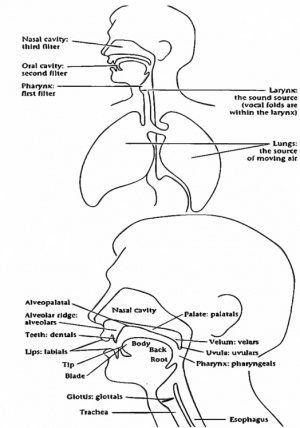Difference between revisions of "Language/Multiple-languages/Pronunciation/International-Phonetic-Alphabet"
| Line 25: | Line 25: | ||
=== Why is the vowel chart shown in trapezoidal shape? === | === Why is the vowel chart shown in trapezoidal shape? === | ||
https://linguistics.stackexchange.com/questions/31455/why-is-vowel-phonology-represented-in-a-trapezoid-instead-of-a-square | https://linguistics.stackexchange.com/questions/31455/why-is-vowel-phonology-represented-in-a-trapezoid-instead-of-a-square | ||
=== Can I just note roughly and without so many details? === | |||
Yes. There are two sets of transcriptions: broad and narrow. If you want to give an idea on how to pronounce roughly, then broad transcription suits that. If you want to note as many details as you can, then narrow transcription. | |||
=== Are phonemes in “phonemic symbols for English” identical with their correspondents in IPA? === | === Are phonemes in “phonemic symbols for English” identical with their correspondents in IPA? === | ||
No. | No. In English, there is no standard set of symbols. If you look up different dictionaries, you can find that they are different. Another factor can add to this complexity: there is no standard language for English, so different dictionaries adopt different dialects. | ||
In English, there is no standard set of symbols. If you look up different dictionaries, you can find that they are different. Another factor can add to this complexity: there is no standard language for English, so different dictionaries adopt different dialects. | |||
Wiktionary is using the IPA, as far as I know. | Wiktionary is using the IPA, as far as I know. | ||
Revision as of 12:40, 15 December 2021
When I learn a language, the books always show a similar phoneme in the learner's known language to tell how to pronounce a phoneme. But that's really not an appropriate method for a language enthusiast, because that is the reason why people pronounce in the target language like in their native language. So it's necessary to learn IPA.
Official website:
https://www.internationalphoneticassociation.org/
Anki deck:
https://ankiweb.net/shared/info/81778780
Wikipedia help:
https://en.wikipedia.org/wiki/Help:IPA
FAQ
What's the difference between voiceless and voiced?
It is whether the vocal cord is vibrating or not when pronouncing the consonant. It's hard to distinguish for a beginner.
Why is the vowel chart shown in trapezoidal shape?
Can I just note roughly and without so many details?
Yes. There are two sets of transcriptions: broad and narrow. If you want to give an idea on how to pronounce roughly, then broad transcription suits that. If you want to note as many details as you can, then narrow transcription.
Are phonemes in “phonemic symbols for English” identical with their correspondents in IPA?
No. In English, there is no standard set of symbols. If you look up different dictionaries, you can find that they are different. Another factor can add to this complexity: there is no standard language for English, so different dictionaries adopt different dialects.
Wiktionary is using the IPA, as far as I know.
How to pronounce trills (e.g. rolling R)?
It requires patience if none of them are in your mother tongue. Just practise, no other way. If you can pronounce a type of trill, you can pronounce another type easier. If you can't succeed anyway, you may consider visiting an oral surgeon.
Guidance:

